Mark Sisson's Blog, page 40
August 28, 2021
Instant Pot Beef Enchiladas – Primal, Paleo, Keto, Grain-free and Gluten-free!
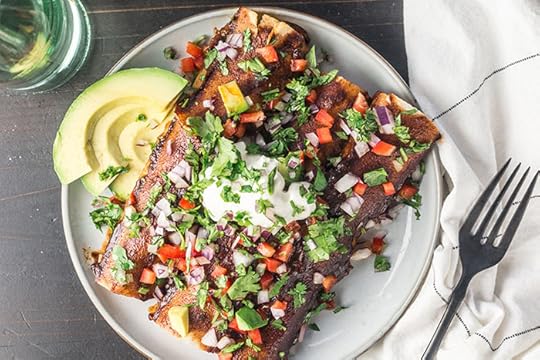
Enchiladas are often a mess of ingredients in a casserole pan, the two main ingredients being tortillas and a heavy blanket of cheese. But it doesn’t have to be that way. In this Primal enchilada recipe, it’s all about the meat.
Chuck roast is slow-cooked and tender with a thick, mildly spicy sauce, and the possibilities for toppings are endless.
Here’s the recipe.
Pressure Cooker Beef Enchiladas Recipe – Primal, Paleo and Gluten-freeIngredientsShredded Beef3 lb. chuck roast, cut into 2-3 inch chunks2 tbsp. avocado oil1 chopped large onion6 chopped cloves garlic1 Tbsp. chili powder1 Tbsp. paprika1 Tbsp. cumin2.5 tsp oregano1 tsp. salt1/2 tsp. black pepper1.5 cups water or broth (if using water, you might want to add more salt)Enchilada Sauce2 tbsp. avocado oil1/4 grated onion2 Tbsp. tapioca starch3 Tbsp. chili powder2 Tbsp. paprika1 Tbsp. oregano2 tsp. garlic powder1/2 tsp. salt2.5 cups chicken brothEverything Else8-12 paleo tortillas (we love Siete brand)chopped onion, pepper, avocado and cilantrosour cream or dairy-free sour cream
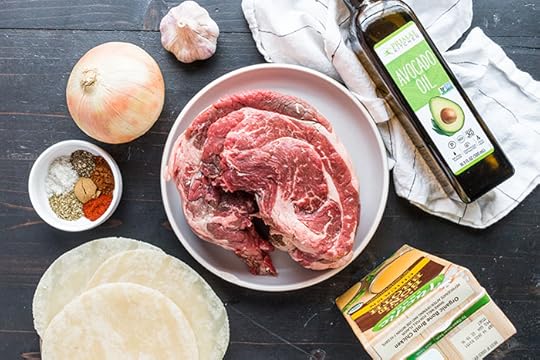
Add the avocado oil to your Instant Pot and set it to the “Saute” function. Once the oil is hot, add the chopped onion and saute for 2-3 minutes, or until they begin to soften. Add the garlic and stir until fragrant. Add the chunks of beef and sear for a minute or two on each side. Add the spices and stir to coat the beef.
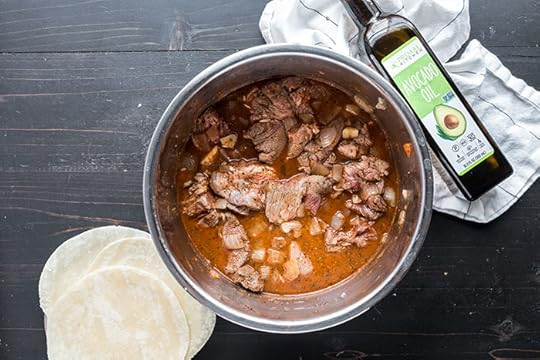
Add the liquid to the Instant Pot and secure the lid. Set it to the manual setting on high pressure for 55 minutes. Once the timer goes off, allow the pressure to naturally release for 20 minutes before opening the Instant Pot.
Preheat your oven to 375 degrees. Shred the meat and pour the meat and at least half of the liquid into a baking dish. Roast for about 20 minutes, or until the liquid thickens a bit and the top of the shredded meat is browned.

While the meat is cooking, prepare the enchilada sauce. In a pot, heat the avocado oil over medium heat. Once it’s hot, add the grated onion and stir. Stir for a few minutes, or until the onion is very soft. Whisk in the tapioca starch, stirring continuously to prevent it from burning. Add the chili powder and paprika and stir. Whisk in the chicken broth slowly. Continue stirring to break up the clumps of spices and tapioca starch. Once the clumps are gone, continue stirring while adding in the oregano, garlic and salt. Allow the sauce to thicken to be able to coat the back of a spoon, then season with salt and pepper to taste.
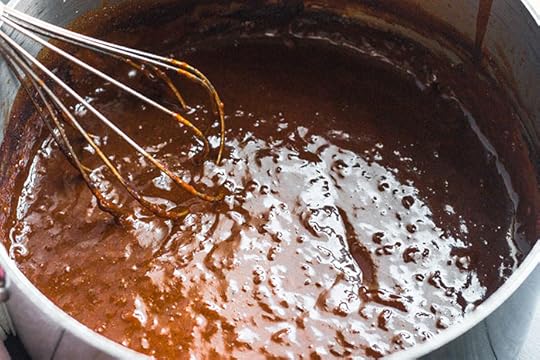
Spray a little avocado oil spray on the bottom of a baking dish. Place a small amount of the pulled meat in a tortilla and roll them up. Place them in the baking dish with the flap portion of the roll ups facing down. Repeat with the remaining tortillas until you’ve filled the baking dish. Pour the enchilada sauce on top of the tortillas.
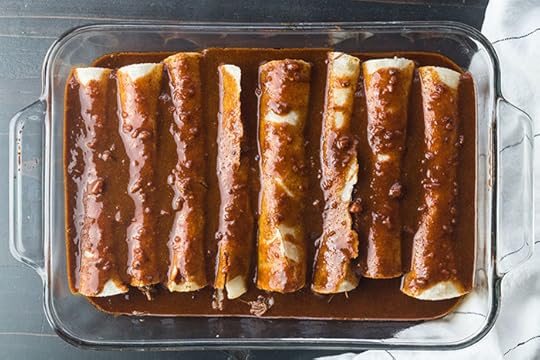
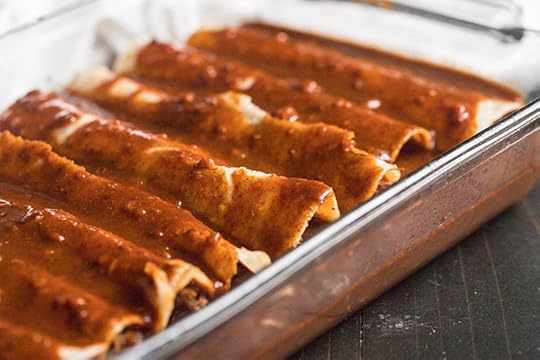
Bake for about 15 minutes. Remove the baking dish from the oven. Top with enchiladas with chopped onion, red pepper, avocado and cilantro. Serve with your favorite dairy-free or regular sour cream or cheese!
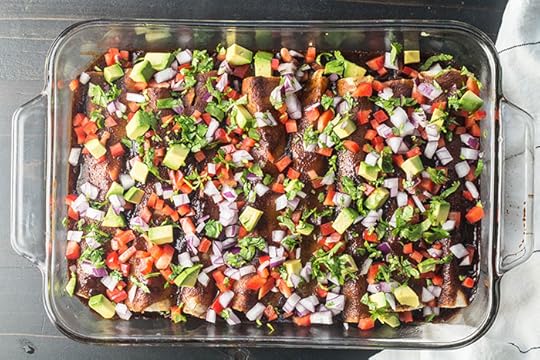

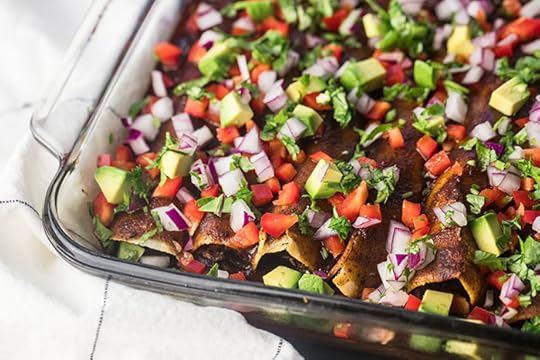

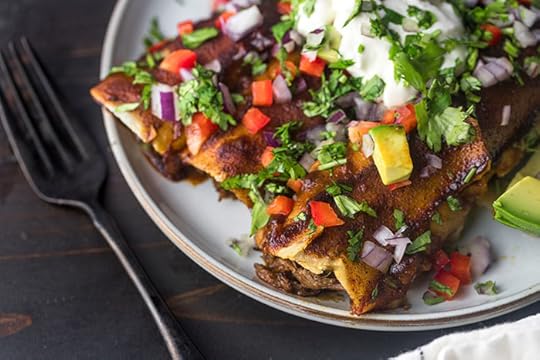
– This will make more beef than will probably fit in your tortillas. The extra meat is delicious with big salads.
– Warm your tortillas before filling them to make them more pliable.
– If you’re short on time, you can use a store-bought enchilada sauce. Siete and Simply Organic both have clean options.
(function($) { $("#dfhboTi").load("https://www.marksdailyapple.com/wp-ad..." ); })( jQuery ); 
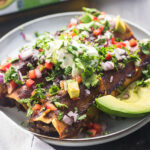 Pressure Cooker Beef Enchiladas – Primal, Paleo, Keto, Gluten-free and Grain-free! Author: Mark's Daily Apple
Pressure Cooker Beef Enchiladas – Primal, Paleo, Keto, Gluten-free and Grain-free! Author: Mark's Daily Apple  Prep Time: 5
Prep Time: 5  Cook Time: 80
Cook Time: 80  Total Time: 1 hour 25 minutes
Total Time: 1 hour 25 minutes  Yield: 8 enchiladas Diet: Gluten Free [image error] Print Recipe [image error] Pin Recipe Description
Yield: 8 enchiladas Diet: Gluten Free [image error] Print Recipe [image error] Pin Recipe Description Beef enchiladas in a thick sauce made paleo and gluten-free, without grain ingredients.
Ingredients Shredded Beef3 lb. chuck roast, cut into 2–3 inch chunks2 tbsp. avocado oil1 chopped large onion6 chopped cloves garlic1 Tbsp. chili powder1 Tbsp. paprika1 Tbsp. cumin2.5 tsp oregano1 tsp. salt1/2 tsp. black pepper1.5 cups water or broth (if using water, you might want to add more salt)Enchilada Sauce2 tbsp. avocado oil1/4 grated onion2 Tbsp. tapioca starch3 Tbsp. chili powder2 Tbsp. paprika1 Tbsp. oregano2 tsp. garlic powder1/2 tsp. salt2.5 cups chicken brothEverything Else8–12 paleo tortillas (we love Siete brand)chopped onion, pepper, avocado and cilantrosour cream or dairy-free sour cream InstructionsAdd the avocado oil to your Instant Pot and set it to the “Saute” function. Once the oil is hot, add the chopped onion and saute for 2-3 minutes, or until they begin to soften. Add the garlic and stir until fragrant. Add the chunks of beef and sear for a minute or two on each side. Add the spices and stir to coat the beef.
Add the liquid to the Instant Pot and secure the lid. Set it to the manual setting on high pressure for 55 minutes. Once the timer goes off, allow the pressure to naturally release for 20 minutes before opening the Instant Pot.
Preheat your oven to 375 degrees. Shred the meat and pour the meat and at least half of the liquid into a baking dish. Roast for about 20 minutes, or until the liquid thickens a bit and the top of the shredded meat is browned.
While the meat is cooking, prepare the enchilada sauce. In a pot, heat the avocado oil over medium heat. Once it’s hot, add the grated onion and stir. Stir for a few minutes, or until the onion is very soft. Whisk in the tapioca starch, stirring continuously to prevent it from burning. Add the chili powder and paprika and stir. Whisk in the chicken broth slowly. Continue stirring to break up the clumps of spices and tapioca starch. Once the clumps are gone, continue stirring while adding in the oregano, garlic and salt. Allow the sauce to thicken to be able to coat the back of a spoon, then season with salt and pepper to taste.
Spray a little avocado oil spray on the bottom of a baking dish. Place a small amount of the pulled meat in a tortilla and roll them up. Place them in the baking dish with the flap portion of the roll ups facing down. Repeat with the remaining tortillas until you’ve filled the baking dish. Pour the enchilada sauce on top of the tortillas.
Bake for about 15 minutes. Remove the baking dish from the oven. Top with enchiladas with chopped onion, red pepper, avocado and cilantro. Serve with your favorite dairy-free or regular sour cream or cheese!
NotesThis will make more beef than will probably fit in your tortillas. The extra meat is delicious with big salads.
Warm your tortillas before filling them to make them more pliable.
If you’re short on time, you can use a store-bought enchilada sauce. Siete and Simply Organic both have clean options.
 Category: Lunch, Dinner
Category: Lunch, Dinner Method: Pressure Cooker
Method: Pressure Cooker Cuisine: Mexican Nutrition Serving Size: 1/8 of recipe Calories: 519.5 Sugar: 1.6 g Sodium: 724.1 mg Fat: 37.7 mg Saturated Fat: 12.9 g Unsaturated Fat: 20.57 g Trans Fat: 0 Carbohydrates: 9.4 g Fiber: 3.14 g Protein: 35.7 g Cholesterol: 125.8 mg Net Carbs: 6.25 g
Cuisine: Mexican Nutrition Serving Size: 1/8 of recipe Calories: 519.5 Sugar: 1.6 g Sodium: 724.1 mg Fat: 37.7 mg Saturated Fat: 12.9 g Unsaturated Fat: 20.57 g Trans Fat: 0 Carbohydrates: 9.4 g Fiber: 3.14 g Protein: 35.7 g Cholesterol: 125.8 mg Net Carbs: 6.25 g Keywords: gluten free beef enchiladas recipe, grain-free beef enchiladas recipe
 Did you make this recipe?
Did you make this recipe? Share a photo and tag Mark's Daily Apple — we can't wait to see what you've made!
(function($) { $("#dfQ9j1o").load("https://www.marksdailyapple.com/wp-ad..." ); })( jQuery ); 
The post Instant Pot Beef Enchiladas – Primal, Paleo, Keto, Grain-free and Gluten-free! appeared first on Mark's Daily Apple.



August 27, 2021
New and Noteworthy: What I Read This Week — Edition 144
 Research of the Week
Research of the Week
Asymptomatic COVID cases aren’t very contagious, and if they do infect others, those infections are more likely to be asymptomatic too.
The more time you spend outdoors in natural light, the happier you’ll be.
Single dose intranasal vaccine works well against COVID in mice.
Control that blood glucose, folks.
New Primal Blueprint PodcastsEpisode 515: Darryl Bosshardt: Host Elle Russ chats with Darryl Bosshardt of Redmond Salt fame.
Health Coach Radio: Jill Coleman on why you need to get into the trenches with your clients.
Media, SchmediaA simple proposal: Reduce sugar, reduce disease.
Interesting Blog PostsThe invention of Crisco was a disaster for the human race.
How Indian vegetarians can get more protein.
Social NotesEverything Else
The math behind muscle building.
Things I’m Up to and Interested InI agree: Raw onions are incredible.
Good news for people who recovered from COVID (like me): Natural infection confers strong, long-lasting immunity.
Great article about our nomadic past: Would you swipe right on a steppe-brother?
Good news for kids: The delta variant is no more severe than the last one.
Interesting site and service: Offering facial reconstructions of ancient skull remains.
Question I’m AskingHave you had COVID?
Recipe CornerSimple and delicious sausage and kale soup.Asian cucumber salad is incredibly refreshing.Time CapsuleOne year ago (Aug 21 – Aug 27)
How I’d Change School— What I’d do different.All About Balsamic Vinegar: Benefits and Uses— How and why to use it.Comment of the Week
“I try to work as little as possible.”
-Solid approach, Hate_me.
(function($) { $("#df0NEHk").load("https://www.marksdailyapple.com/wp-ad..." ); })( jQuery ); 
The post New and Noteworthy: What I Read This Week — Edition 144 appeared first on Mark's Daily Apple.



Don’t Give Up, You’re Just on the Other Side of a Breakthrough
 I love those posts about famous people who didn’t reach their stride until mid-life. Or ‘til after receiving hundreds of rejection letters. Or following some huge life-altering experience. Like George Lucas who got turned down by three major movie studios. Michael Jordan who got cut from his high school basketball team, twice. The dude who started FedEx who allegedly got a C on his college term paper promoting the original biz idea.
I love those posts about famous people who didn’t reach their stride until mid-life. Or ‘til after receiving hundreds of rejection letters. Or following some huge life-altering experience. Like George Lucas who got turned down by three major movie studios. Michael Jordan who got cut from his high school basketball team, twice. The dude who started FedEx who allegedly got a C on his college term paper promoting the original biz idea.
They’re all well-known now (well most of them), but without special skills like tenacity, self-compassion, and flat-out trusting the process, they might not have ever gotten there.
The same thing goes for those of you struggling with sticking to a primal or keto diet, or trying to stretch out your fasting window by a few more hours, or ramping up your workout routine. I see it fairly frequently with my health coaching clients. They’re diligently following their real-food-eating-plan, tuning into their hunger levels, and moving their bodies regularly, then suddenly, there’s some obstacle that totally derails their hopes and dreams of success.
Obstacles can look like:
The number not budging on the scaleLack of support from friends or partnersGeneral self-doubtLack of motivationFear of the unknownTemptationChronic stressBreakthroughs are Never LinearThe path to anything, be it fat loss, healing, PRs, or personal growth, is never a straight line. It’s curvy, messy, and often times chaotic. It’s just part of being human. And although it feels like you’re not making progress, you actually are.
It’s like in the old days before electric drills and powerful jackhammers were a thing, they used to break boulders with handheld sledgehammers. Workers would hit those darn things over and over again without seeing any progress, but they’d keep at it because that was their job. Then, on the 50th or so hit, the boulder would magically split in half. Except it wasn’t magic, it’s science. They’re breaking down the integrity of the structure, each hit microscopically chipping away at it.
Just like my boulder analogy, the same thing is happening to you and your goals. Even though it looks like nothing is happening on the outside, each time you choose bacon and eggs over a jumbo Costco-sized muffin or go for a walk even when you don’t feel like it, you’re shifting something key to your success on the inside.
Why You Need Resiliency
When you’re armed with this knowledge ahead of time, you can lessen the powerlessness that can tag along for the ride. You know, the feeling like you’re banging your head against a wall that doesn’t ever move. People with a sense of resiliency are usually the most successful at persevering the ups and downs of their struggles. They’ve learned how to adapt, emotionally and physically, in the face of adversity. Not only does this help them keep a positive mindset, it prevents them from giving up — which, really is the biggest piece of this puzzle.
The Three Cs of ResilienceResiliency isn’t just something you’re born with either, you can learn to develop it. According to research by Susan Kobasa, a psychologist who studies hardiness and grit, there are three elements essential to resilience:
Challenge. As in, challenge your thoughts. When you reframe a stressor as an opportunity to grow versus something to be dreaded or threatened by, you’re more equipped to move through it. That’s true for setbacks too. You can choose to view them as feedback, not failure or a reflection of your self-worth.Control. Knowing what you can control and what you can’t is crucial here. Those who lack resilience often spend time stewing over uncontrollable events, which can create a feeling of helplessness and powerlessness. In contrast, putting your efforts toward situations where you can make an impact leads to feelings of empowerment and confidence.Commitment. Are you committed to following through even when the going gets tough? Or are you only willing to go ‘til it gets uncomfortable? Resilient people are dedicated to taking action until their goal is met, regardless of the obstacles that arise.Basically, resilience helps you handle stress in a more positive way. A study by developmental psychologist Emmy Werner backs up that thinking. She followed a group of 698 kids from birth through their third decade of life, monitoring their exposure to stress along the way. Two-thirds of the subjects came from stable, successful backgrounds while the other one-third were qualified as “at risk.” Of the at-risk kids, she discovered that some developed significant behaviour and mental health problems, while a small subsection of the group achieved academic, domestic, and social success.
Sifting through the data, Werner learned that there were several elements that predicted resilience, most of which had to do with how the children responded to their environment, adding that the resilient kids had what psychologists call an internal locus of control — they believed that they (not their circumstances) had the biggest impact on their accomplishments.
Are You on the Verge of a Breakthrough?The reason resiliency is so important here is that breakthroughs typically happen right as (or after) you hit your breaking point. And you want to have the skills to actually get there and persevere. While some of these signs may seem negative on the surface, they mean that you’re on the right path, and that a breakthrough is right around the corner.
You notice an increase in resistance. Does it seem like it’s harder to do the things you’re trying to do? Maybe you’re up against a physical challenge like an injury, or your spouse continually brings home donuts. Resistance to opening a new door in life is always strongest right before you get to that door. So don’t let these obstacles derail you. Also don’t take them as a sign that whatever it is you’re working toward isn’t worth it. In contrast, it’s a sign you’re on the brink of something great.You feel like giving up. Self-doubt typically stems from previous negative experiences and limiting beliefs. And it’s completely normal, especially when you’re up against a goal that’s important to you. Know that never wanting to quit isn’t a sign of strength, it means your goals are too small. Big goals will always elicit some level of self-doubt, so take this opportunity to lean into that feeling even more.You want to change your goals. Ditching sugar or grains might have felt like a great idea a few weeks ago, but suddenly, in the midst of pumpkin-spice-everything, you’re not so sure. Think of working on your goal like hiking up a mountain. There’s always going to be places where you feel like stopping or turning around and heading back to your car. But instead of settling (or hiking up a different mountain), stay the course. The view from the top is 100% worth it.You’re uncomfortable more than you’re not. Most people life their lives on autopilot, staying within the cozy confines of their comfort zones. If you’re at a point where most of the time you’re feeling unsure, scared, doing things you’ve never done before, and wondering why the heck you’re even doing them, congratulations, your breakthrough is definitely on the horizon.You find something that clicks. I realize there’s a lot of potential discomfort in these signs — after all, who wants to be faced with fear, self-doubt, and uncertainty on an almost-daily basis? But when you stick with it long enough, you’ll reap the rewards. With enough resilience (and an understanding that you’re headed in the right direction), you’ll get to a point where everything starts to fall into place and your path becomes crystal clear. That’s when you know you’ve reached the other side.Don’t Give Up, You’re Almost ThereMost people give up before the good stuff happens. Right before they see the results, get the PR, or fit in the smaller pant size. If you’re feeling frustrated, filled with doubt, or wondering why you ever started working toward your goal in the first place, let this be your invitation to stay the course. These five signs mean that you’re just on the other side of a breakthrough:
You notice an increase in resistanceYou feel like giving upYou want to change your goalsYou’re uncomfortable more than you’re notYou find something that clicksHow about you? What signs do you notice when you’re getting close to a breakthrough?
(function($) { $("#dfr9sQ0").load("https://www.marksdailyapple.com/wp-ad..." ); })( jQuery );
The post Don’t Give Up, You’re Just on the Other Side of a Breakthrough appeared first on Mark's Daily Apple.



August 25, 2021
What We Can Learn From Kids
 It’s one thing to look at studies. What if we look at “finished products”? What if we look at whole organisms that appear to be doing things right and try to learn from them? People are always looking at the “Blue Zones” or this guru or that celebrity and trying to glean insights about healthy diet, lifestyle, and behavior. I say expand that outlook to encompass other populations you might not have considered. LIke kids.
It’s one thing to look at studies. What if we look at “finished products”? What if we look at whole organisms that appear to be doing things right and try to learn from them? People are always looking at the “Blue Zones” or this guru or that celebrity and trying to glean insights about healthy diet, lifestyle, and behavior. I say expand that outlook to encompass other populations you might not have considered. LIke kids.
Kids are kids. We tell them what to do, they learn from us, and they are put on this earth to watch us and do what we do. What if we flipped that? What can we learn from watching kids? How do children approach life, health, and movement—and what can we take from that approach and apply to our own lives?
Here’s what we can learn from kids.
Keep asking why.Kids never stop asking why. They don’t just accept answers from authorities because they want to understand why the answer is what it is. They want to know your reasoning. They take nothing for granted, even or especially such “mundane” facts like the sky being blue, rain falling from the sky, and dogs having fur.
Never stop asking why. The eternal student doesn’t just learn more. The eternal student is never bored.
Never stop moving.If you watch your kids, they don’t stop moving. They fidget. They dance. They stand up then sit down then stand up again. They twitch and pace the room and climb over furniture. Even if they’re sitting in a chair, they’ll rock, lean back, sit on their knees, and never stop moving. Kids are constantly adjusting their position throughout space and time. And while you can’t say their constant movement is a cause of children’s well-avowed high metabolic rate and energy expenditure—it’s most likely both cause and effect, a virtuous cycle—we can still emulate their.
Now, don’t fidget in the board room. Don’t climb on the desk during a job interview. But constant movement is one path to better health, and it will keep you limber, supple, mobile, and energetic. Try moving throughout the day for a solid week and see how you feel. See if you’re less stiff. See if you have more energy. I bet you will.
Sprint more.
Kids sprint everywhere. Watch kids at play together and they don’t just walk slowly and orderly in single file lines. They dash off to go play, run up and down hills, sprint up the stairs. If they want to go somewhere, they go and they go quickly. But, and this is crucial, they aren’t sprinting non-stop. Unless they’re playing freeze tag or some other playground game, they sprint and then rest. They sprint as a mode of transportation, not training. Kids aren’t concerned with “working out” or “running intervals.” They go hard, as hard as they can, and then stop when tired and do something more quiet and sedentary until it’s time to sprint again.
They are the perfect example of moving frequently at a slow pace walking/fidgeting/playing on the floor doing relatively sedentary low level movement interspersed with bouts of all out high intensity sprinting.
Eat whole foods that taste good.Kids at least from the start of their lives absent processed food have pure appetites. Before their taste buds and reward systems are corrupted by industrial foods expressly designed to corrupt by food engineers, they make excellent food choices. In one old study, researchers took a group of breastfed infants and. placed a broad selection of whole foods in front of them. Without any adult input, the kids chose what to eat from the following foods:
Bone marrow, bone jellyBeef, lamb, and chicken muscle meatLiver, kidney, brain, sweetbreadsHaddockCod liver oilWhole wheat cereal, whole barley cereal, oats, corn, ryeEggsRaw milkOranges, apples, tomatoes, peaches, pineapples, bananasCabbage, carrots, turnips, potatoes, peas, beets, spinach, cauliflowerEach kid took a different route. They all chose different foods. Some ate a fruit and meat-heavy diet. Others ate more grains. Some kids ate a ton of fish and organs. But whatever they ate, they managed to satisfy their nutrient requirements. One child even cured his rickets by eating a ton of cod liver oil. He didn’t know he was low in vitamin D. He didn’t know what vitamin D even was. They just knew what they needed. They ate what was most appealing in the moment and managed to provide what their bodies required. Amazing, right? Or is it just normal?
Embrace awe.Children are in constant awe of the world around them. Of course if they have their nose in a tablet all day that sense of awe quickly gets subsumed and extinguished. But if you take a four-year-old kid out for a hike through the redwoods or along the water or anywhere natural they are in awe of everything around them. The bird overhead, the squirrel scampering up the tree, the sand crabs bubbling under the sand, the waves crashing, the seagulls swooping overhead. In the past I have written about the importance of cultivating a sense of awe, and I stand by it. You can get that back, even as an adult who’s “seen it all.”
“Awe researchers” induce awe in regular adults by showing them nature scenes on television screens or having them stand in eucalyptus groves on college campuses and looking up. Awe isn’t hard to find. It’s all around us.
Play more.Get five kids in an empty room and within ten minutes they’ll have figured out a game to play.
Get five adults in an empty room and within ten minutes they’ll be crawling up the walls trying to deal with the awkwardness and boredom.
Don’t be like the adults. Be like the kids.
This appears to be the secret to life. Kids turn everything into a game. And the adults who live the best, longest, happiest lives do the same. They laugh about life, they joke around. And of course, play for adults looks different than kids at play. I wouldn’t necessarily recommend you go play cops and robbers or play with Barbies. The point is to find something that you enjoy doing, particularly with other people (but not necessarily). Something where the reward is the activity itself, not some goal or prize glittering at the end of the game. Bonus points if it’s physical play.
I’ve long made this a cornerstone of my life: the insistence on play. For too long, I trained to endure. I trained to win races. I trained so I could deal with more and more pain and suffering. And it ended up being a self-fulfilling prophecy, as I grew unhealthier and unhealthier and accrued more and more damage. But when I made the switch to training so I could play—Ultimate Frisbee, standup paddling, snowboarding, and anything else I truly enjoyed doing—everything opened up.
Trust your intuition.Kids come into this world with nothing but their intuition. They don’t have “empirical evidence.” They don’t have “research.” They don’t even have language—they can’t get advice from people. All they have is instinct, urges, and intuition to guide them. Oh, and the benevolent helping hand of their parents and other caregivers. But mostly it’s just the feeling that something is right or wrong, good or bad, healthy or unhealthy.
You still have intuition, and it’s still worth heeding, it’s just drowned out by the stories and narratives other people, society, and even your own brain tell you. The little voice inside you that instantly reacts to a situation, a person, or a choice is your intuition. You can still say no to that initial reaction, that gut feeling, but you should at least consider and vet it.
Embrace magic.It doesn’t matter if magic is “real” or not. For one, we can’t really even define magic, can we? What we can know is that children readily ascribe huge amounts of meaning to seemingly inconsequential natural phenomena. And perhaps they’re right to do it.
Dragonflies actually look an awful lot like dragons if you look closely. They shimmer. They hover. They dart to and fro. They’re brightly colored, almost scaly.
Making a wish before blowing a dandelion—what if it does work? What if by envisioning what you want to occur and then consecrating it with the forced dispersal of dandelion seeds into the spring wind you trigger something in your subconscious that drives you to accomplish the goal and never give up? Isn’t that a kind of magic?
Be present more.Kids are often extremely present. They focus on the moment, the situation at hand. They squat down to look at the ant trail. They spot the turtle in the pond before anyone else. They can play, and dance, and read and really be there for the moment. They aren’t thinking about the bills, or the fact that they have to go into work tomorrow, and yes, that’s a bit of a luxury because they by and large don’t have as much to worry about. But we can learn from that. We can inject some of that presence into our own lives.
I won’t say “be present at all times.” Sometimes it’s good to be distant from the situation at hand and sometimes we need to worry about the future, but adults are way too good at doing that. We’ve got “lack of presence” in the bag. Most of us need more presence.
Lose yourself in your pursuits.I can remember playing in the woods from morning til dusk, not eating, not drinking, ignoring the skinned knees because the immediacy of the moment and our pursuit demanded our full attention. That was true living. That was an archaic form of flow that every biohacker and meditator and nootropic-taking coder would pay thousands to tap into.
If you can capture that, if only for an hour or two a day, you will become unstoppable.
Stop eating when you’re not hungry.Kids are finely tuned metabolic machines. This is why you get so many struggles at the dinner table—a kid won’t be hungry but his parents will force him to keep eating. Or a kid won’t eat anything all day and then wake up and eat six eggs, two potatoes, one banana and two glasses of milk. It’s hard to understand as a parent, and even I had issues dealing with our kids not eating their meals, but eventually I learned to trust them.
What it comes down to is that kids stop eating when they aren’t hungry, as long as they’re eating whole foods and not processed industrial junk. If you did the same, you’d have a lot less issues with your weight. Now, this is easier said than done. We aren’t kids with pristine metabolisms. We’ve had decades to cultivate dysfunctional appetites and satiety mechanisms. But if you look deep within, you’ll see glimmers of the old signals telling you when you’ve had enough food. Listen to them.
(function($) { $("#dfX4F1R").load("https://www.marksdailyapple.com/wp-ad..." ); })( jQuery ); 
The post What We Can Learn From Kids appeared first on Mark's Daily Apple.



August 24, 2021
How to Go Primal with Food Allergies, Intolerances, and Restrictions
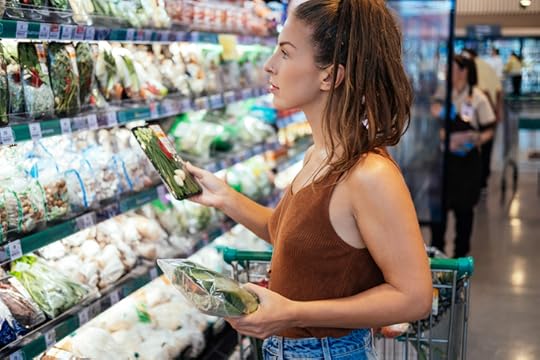 She is standing, holding product and reading nutrition facts.
She is standing, holding product and reading nutrition facts.We Primal folks love our giant omelets, guacamole burgers, and dark chocolate smeared with coconut butter — but what about when those foods don’t love us back? Over the years, I’ve heard from countless readers with food allergies, food restrictions, and simple food preferences who worry that Primal might not be for them.
These folks are interested in giving the Primal Blueprint lifestyle an honest shot, but they can’t eat certain foods, many of which enjoy an exalted place (real or imagined) in our community. So what’s the verdict? Can you go Primal without eating red meat? Coconut products? Avocado? Can it be done as a vegetarian? Are almonds essential?
Food allergies and intolerances frequently represent nothing more than minor speed bumps in your path, but some are more tedious than others. How hard will it be for you to eat Primally with your specific dietary needs? Let’s find out. Then scroll to the bottom for some general food allergy FAQs.
Tree Nut and Coconut Allergies — Wait, Are Coconuts Tree Nuts??I’m allergic to tree nuts…and they are such a big part of the Primal Blueprint diet. Is it possible to still succeed on the plan in a healthy way without eating nuts?
Definitely. I actually wouldn’t say that tree nuts are a “big part” of the eating plan. The centerpieces of Primal eating are animal products (meat, fish, fowl, eggs, and dairy products if tolerated) and produce (vegetables and in-season fruit). Nuts, seeds, and their derivative butters are extras that you can add as desired. They certainly aren’t necessary.
Many people who are just starting out with Primal turn to nuts as their go-to snacks, because they’re low-carb, high-fat, and relatively convenient. This gives nuts the allure of essentiality. They are not. Nuts make a fine snack, sure, but they also tend to run pretty high in omega-6 fats. It’s also easy to overdo it on the nut butter and unintentionally undermine weight-loss goals.
You won’t be missing much by avoiding nuts. You certainly won’t be missing anything that you can’t get from other foods. And the good news is, you can probably still consume coconut products. Technically, the FDA categorizes coconuts as tree nuts, but they’re more accurately classified as drupes, a kind of fruit. It’s possible to be allergic to both, so don’t pound a stack of coconut flour pancakes if you’re not sure about your coconut allergy status. Get tested by your allergist first.
My daughter is allergic to almonds. What almond flour substitutes can I use in my recipes? Can I just substitute coconut flour for almond flour in Primal/paleo recipes?
Coconut flour is probably going to be your best option, but it’s nothing like almond flour. Coconut flour is far drier, with more fiber and less fat than almond flour. You can’t substitute coconut flour 1:1 for almond flour without getting a very different final product. I always recommend looking for a recipe that has been tested with the flour you want to use rather than trying to substitute a different flour.
If coconut flour isn’t your jam, there are alternatives. Cassava flour is the most recent darling of the grain-free baking community. Tigernut flour sounds the coolest, but it’s perhaps not your best bet for baking. Check out this post for more options: 8 Primal-Friendly Flours.
You can also buy gluten-free baking blends that are usually built on a base of rice flour. Despite what you might think, I don’t think white rice is terrible, especially not for insulin sensitive or highly active folks who don’t mind the carbs. These baking blends are convenient because they can usually be subbed into any recipe that calls for regular all-purpose flour.
However, I’m obligated to remind you that even Primal-friendly baked goods are still baked goods. Nutrition-wise, they’ll never stack up against a Big-Ass Salad or juicy steak with a side of grilled veg. Be mindful about over-relying on them.
I have been intermittently following a Primal lifestyle, but have had difficulty transitioning my household to it because my husband is allergic to coconut in all its forms. How do you go Primal when you can’t have coconut milk, coconut cream, coconut flour, etc.?
Although coconuts are popular with this crowd, they are not essential either. Yes, they taste good and provide healthy medium-chain saturated fats, but so do palm oil and dairy fat. Both can be worthy replacements. Go with grass-fed dairy fat and ethically sourced unrefined red palm oil, and you get extra vitamins and nutrients along with your medium-chain triglycerides.
“No coconut” isn’t a dealbreaker. Here’s how you swap out coconut in recipes:
Instead of coconut flour: See my answer to the question above. Look for recipes that use almond or other nut flours, cassava flour, tapioca starch, green banana flour, or a gluten-free baking mix (check the ingredients, though).Instead of coconut milk or coconut cream: Full-fat milk, half-and-half, heavy cream. Nut milks might work too depending on the recipe, but they are usually more watery and contain less fat.Instead of coconut butter: Cocoa butter is probably your best bet, but it has a higher melting point and will impart a slightly chocolate-y flavor. That might work in your favor if you’re making something like fat bombs.Instead of coconut aminos: Use gluten-free soy sauce. Yes, it’s soy, but it’s fermented. Presumably, you’re not drinking glasses of it anyway.Avocado Allergy… Or Histamine Intolerance?
I didn’t know this was possible, but I’ve discovered I’m allergic to bananas and avocados. What are good substitutes for these in any recipes?
You can definitely be allergic to avocados and bananas. The fruits actually share a protein in common with latex, so some people who are allergic to latex might develop allergies to bananas and avocados as well. Certain pollen allergies can also be triggered by bananas and avocados.
It’s also possible that you’re actually suffering from histamine intolerance. Symptoms are similar to an allergic response: hives, vomiting, congestion, and/or headaches. Histamine intolerance can also lead to gastrointestinal distress when you eat high-histamine foods. Pay close attention to how your body reacts to things like fermented foods (sauerkraut, pickles, kimchi, yogurt, vinegar, kombucha, etc.), bone broth, and cured meats. You might need to limit those, as well.
In terms of substitutes, in smoothies try yogurt (assuming an allergy and not a histamine intolerance), frozen fruit, or coconut cream. This may sound odd, but frozen macadamia nuts tossed in a smoothie provide a buttery texture that, while not perfectly analogous to that of a frozen banana or avocado, stands up well on its own merits. In Primal baked goods, unsweetened applesauce can replace mashed bananas. If you’re missing the fat content of the avocado, both olive oil and macadamia oil contain similar amounts of monounsaturated fats.
Now let’s talk guacamole. Apparently, you can make a very decent guacamole substitute with tomatillo and squash such as chayote. Recipes abound online. Let me know if you try it!
My kid is allergic to avocados. Avocado oil used to be my go-to cooking oil. What do I use instead??
Olive oil, coconut oil, tallow, lard, duck fat, recycled bacon grease, butter, ghee.
What About Folks with Multiple, Diverse Food Allergies or Intolerances?I am allergic and/or intolerant to eggs and dairy and coconut (in addition to wheat, soy, yeast, etc.). Do you think it is possible for me to go Primal in that circumstance?
Yes. In some ways, it’s simpler. You just eat meat, vegetables, fruit, and nuts.
Before you start feeling deprived, sit down with this Primal Shopping List and write out your own list of foods you enjoy or are willing to try. I bet you’ll end up with quite a lot. But let’s say you’re a picky eater, and you find this way of eating too restrictive. You always have the option of adding back some “borderline foods” like legumes, quinoa, and rice, assuming they work for you.
Since you’re not eating yogurt or kefir or some other fermented dairy, which is how many people work fermented foods in their diets, you should look into lacto-fermented vegetables, like sauerkraut, kimchi, or pickles.
I Can’t (Or Won’t) Eat Meat. Can I Still Be Primal?I can’t stand red meat. I know grass-fed beef and lamb are the bee’s knees, but I just can’t do it. Am I making a huge mistake?
Since you asked – yes. I can’t imagine voluntarily giving up a grass-fed, bone-in ribeye or perfectly prepared lamb chops with mint chimichurri. But that’s sheer hedonism. As far as nutrition goes, you’ll largely be fine.
Incorporate grass-fed dairy fat and you’ll make up for the lack of conjugated linoleic acid. Eat oysters a couple times a week and you’ll take care of the missing zinc. Make sure the animal products you do eat come from quality sources. I’m talking grass-fed and -finished, pastured, and/or wild-caught as budget allows. You may have trouble getting enough carnitine, an important amino acid found almost exclusively in red meat. While the body both conserves carnitine quite well (indicating, perhaps, its importance in the body) and manufactures it internally, more carnitine has been shown to be helpful, especially in athletes and the elderly. If you’re not eating red meat, you’re likely getting far less carnitine than most traditional Primal eaters.
If I could make one suggestion, it would be to eat a quarter pound of pastured ruminant liver every week. I know that’s a tall order, seeing as how you can’t stand the taste of red meat, but try to do it if you can. The benefits are many (it isn’t called “nature’s multivitamin” for nothing), and since carnitine is synthesized in the liver, a small weekly dose might make up for the overall lack of red meat. At the very least, include chicken, duck, or turkey livers.
All of a sudden, I get really sick when I eat meat. My doctor thinks I have alpha-gal syndrome. What does this mean in terms of being Primal?
As you know, alpha-gal syndrome is a severe allergic reaction to foods that come from mammals. This includes meat and organs for sure and often dairy products as well. Some people with alpha-gal syndrome also need to avoid things like gelatin, carrageenan, and other mammalian byproducts. Alpha-gal syndrome develops following a tick bite, usually, but not exclusively, from the Lone Star tick.
Don’t take any chances until you consult with your doctor, who can help you determine your level of sensitivity. You can still be Primal eating seafood, fowl, and eggs as your main sources of protein. Talk to your doctor about supplemental carnitine, too. Good luck!
I don’t eat fish. It’s not because I do not want to, but I simply cannot get over the taste after having a bad run-in with raw catfish in my less-than-primal-healthy eating days. Outside of the obvious (grass-fed meats, free-range eggs, supplementation), what are other steps I need to take to keep optimal and Primal?
Can you eat shellfish? Oysters and mussels would take care of all your sea-related needs, if you can tolerate them. Canned, smoked oysters are pretty mild, and I’m of the opinion that oysters are the most nutritious of the edible sea creatures. Hopefully, you can keep them down.
If not, exclusively eating grass-fed meats, pastured eggs (which have a decent amount of omega-3s, believe it or not), and supplementing with a high-quality fish oil will get you on your way. I would also try incorporating some seaweed a couple days a week, if only for the iodine (which can be tough to obtain if you’re abstaining from seafood). A good way to do it is to add pieces of kelp/kombu to soups or cooking bone broth. I don’t find it influences the flavor too much, but it definitely influences the nutritional content of the dish. Seaweed salad, the kind you find in Japanese or Korean cuisine, is also great.
I’m a vegetarian for ethical reasons. Is it possible to go Primal and not eat meat?
Yes, though it wouldn’t be ideal.
As long as you’re avoiding grains, refined sugar, and processed seed oils—and liberally eating the high-quality animal products you do feel comfortable consuming—it can be done. Hopefully you really like eggs and dairy. Make sure the dairy and eggs you eat are of the utmost quality. Get eggs with dark orange yolks from pastured hens who ate grass, weeds, and bugs. Get dairy from cows, goats, or sheep who ate grass. Include some fermented dairy in there as well. A quality whey protein may also help with protein needs.
If you’re the kind of “vegetarian” that eats fish, this won’t be nearly as difficult. Even if you are not, I urge you to at least consider eating bivalves like oysters, mussels, and clams. They don’t seem to have a central nervous system or experience pain as we understand it, plus bivalve farming is neutral-to-beneficial for the local ecosystem.
I would also look into eating insects. Research shows that they experience “pain” differently than most other animals, and they’re a good source of protein, fat, and multiple micronutrients. They’re also extremely eco-friendly, sporting the largest biomass of all terrestrial animals. Most hunter-gatherer societies with steady access to bugs utilize them as a useful source of calories. Why not us?
I’m a vegan. I don’t eat any animal products. Is there any way to be Primal and a vegan?
I’m not going to lie, it’s very, very difficult to do without compromises and extensive supplementation. Where are you going to get creatine? Carnosine? Carnitine? DHA? Zinc? You’re going to have to supplement.
That said, you can certainly be a far healthier vegan by implementing many Primal principles. Avoiding sugar and vegetable and seed oils will be hugely beneficial, but you’ll also need to steer clear of grains to be truly Primal. In their place, you’ll probably have to include more starch, like yams, sweet potatoes, potatoes, and other roots and tubers, as well as fruit, simply for the calories, because you can’t live on leafy greens alone. You don’t have the enlarged intestines of a silverback gorilla. That means you’ll probably end up eating more carbs than the average Primal adherent, but that’s not a bad tradeoff, all things considered.
For protein, consider incorporating:
NutsLentils (generally considered the least offensive legume)Quinoa, a high-protein pseudo-grain (though it contains saponins, which may have antinutrient qualities)Protein powdersAnd once again, please, please consider the lowly bivalve. Yes, they are technically animals, but they don’t come with any of the objections that drive most people to become vegans in the first place.
Thanks for reading!
Food Allergy and Intolerance FAQsWhat is the difference between a food allergy and a food intolerance?Food allergies are characterized by an immune system reaction to a particular food or ingredient. Allergic reactions can be life-threatening. Food intolerances usually involve the digestive system. While intolerances might make you feel crummy, they aren’t acutely dangerous. Still, you should avoid foods you don’t tolerate.
What are common food allergies and intolerances?It’s possible to be allergic to or intolerant of pretty much any food. The most common allergens are milk and dairy products, eggs, peanuts, tree nuts (including almonds, Brazil nuts, cashews, hazelnuts, macadamia nuts, pecans, pine nuts, pistachios, walnuts), soy, wheat, fish, and shellfish.
Is coconut a tree nut?According to the Library of Congress, coconuts are a nut, fruit, and seed. What an overachiever! The FDA classifies coconuts as tree nuts for food labeling. However, you won’t necessarily be allergic to coconut just because you have a tree nut allergy. Have your doctor test you.
How do you test for food intolerances?Some lab tests exist, but their reliability is questionable. The best way is a simple elimination test. Stop eating the food(s) you suspect you don’t tolerate for several weeks. See if your symptoms improve. Then, optionally, slowly reintroduce one food at a time and see if symptoms return.
Can I eat according to the Primal Blueprint if I can’t (or won’t) eat _____?The Primal Blueprint is infinitely adaptable to your food tolerances and preferences, budget, and locale. Primal eating focuses on animal products (meat, fish, fowl, eggs, dairy) and produce (vegetables, fruit). You should be able to craft a well-rounded diet out of the many options available to you.
(function($) { $("#dfSBM2H").load("https://www.marksdailyapple.com/wp-ad..." ); })( jQuery );
The post How to Go Primal with Food Allergies, Intolerances, and Restrictions appeared first on Mark's Daily Apple.



August 20, 2021
New and Noteworthy: What I Read This Week—Edition 143
 Research of the Week
Research of the Week
The presence of ketones in the blood upregulates a biomarker associated with better brain health.
Time-restricted eating paired with strength training sheds fat and builds muscle.
Less selenium, worse glucose control.
More protein at breakfast, less subsequent hunger.
New Primal Blueprint PodcastsEpisode 514: Danielle Schaaf: Host Elle Russ chats with Danielle Schaaf, a faith-based life coach.
Health Coach Radio: Allison Tenney wants you to bet on yourself.
Media, SchmediaPleasantly surprised by this list of most eco-conscious foods.
Interesting Blog PostsHow diet can affect type 2 diabetes.
Imagine thinking like this about everything you eat.
Social NotesEverything Else
The world’s greatest ape, folks.
Isn’t being in space enough?
Things I’m Up to and Interested InSometimes it only takes a little: Just 80 acres.
Nature knows: Prescribed burns that emulate natural patterns can reduce catastrophe.
True: Another important public health crisis.
Good to see sleep in the popular media: Olympian sleep tips.
Interesting article: On ancient perfume.
Question I’m AskingDo you work remote or in-person?
Recipe CornerBeautiful braised purple cabbage.King oyster mushroom salad.Time CapsuleOne year ago (Aug 14 – Aug 20)
Is Stevia Safe, or Bad For You?— Well, is it?Ambiguous Loss: It’s Okay to Grieve— It’s alright.Comment of the Week
“I regularly talk to strangers. I rarely find someone who is rude about that, one woman in California while we were on vacation was memorable but apparently she thought I was a “nothing” and not worth her time, ok then, we don’t have to talk. I ride the train sometimes and talk to people who seem to be ok with it. One was a person who just got out of prison, I knew the judge that put him there and another was a person that knew where I worked (at the jail courtroom) and recognized me. Both were nice, pleasant people who were getting their lives on the right track. I got to color with a young person on a flight, taught me to bring colored pencils or crayons and coloring books with me on trips. I look directly in people’s eyes (because it’s not offensive where I live) and smile at them. One person walked by, came back and thanked me for the smile. I like talking to people, probably learned it from my mom.”
-Interesting, 2Rae.
(function($) { $("#dfLqFj9").load("https://www.marksdailyapple.com/wp-ad..." ); })( jQuery ); 
The post New and Noteworthy: What I Read This Week—Edition 143 appeared first on Mark's Daily Apple.



August 19, 2021
Ask a Health Coach: Fasted Exercise, Chronic Cardio, and Microworkouts
 Hey folks! In this week’s Ask a Health Coach, Erin is answering your questions about how to fuel on race day, why overdoing cardio is linked to burnout, and how to squeeze more (effective) exercise into an already busy day. Post your questions over in the Mark’s Daily Apple Facebook group or down below in the comments.
Hey folks! In this week’s Ask a Health Coach, Erin is answering your questions about how to fuel on race day, why overdoing cardio is linked to burnout, and how to squeeze more (effective) exercise into an already busy day. Post your questions over in the Mark’s Daily Apple Facebook group or down below in the comments.
Dean asked:
“I’m walking a 10K a week from today. I can do it fasted, and have so before, but is there any benefit to having some carbs, protein, or fat before my event?”
It’s never a good idea to try something different on your event day. This is the day you’re putting all your hard work to the test, so don’t be tempted to introduce anything new. That goes for what you put on your body and what you put in it.
Here’s Some Food for ThoughtSure, there’s tons of info about fat-adapted athletes who follow the train low, race high school of thought. The difference is, they’ve practiced it before they get up to the starting line. These athletes know how different sources of fuel feel in their stomach, if it makes them nauseous once they start moving, or if it makes them feel energized. They’re definitely not grabbing a few dates or a pack of almond butter on their way out the door, crossing their fingers, and hoping it works.
If you typically exercise fasted (and are fat adapted), eating before your race may decrease performance. And really, seeing as you’ll be moving at a low-ish intensity, I’d doubt that any kind of carb-protein-fat mix would move the needle too much anyway.
But the bigger question here is, if you’ve trained fasted and with fuel, why wouldn’t you choose the method you’ve found works best for you? Why would you totally discount something you’ve tried — and seen the real-time results — in lieu of advice that may or may not work for your body?
Why We Don’t Trust Our GutMaybe you’ve seen others carb-it-up before a race and constantly crush their goals. Or they swear by slower-burning sources of fat or protein. Deep down, you know what your body requires. You might not think you do, but you do. And usually, when you doubt your own inner knowing, it’s because you’re comparing yourself to other people and questioning your own ability to live up to the challenge at hand.
A certain level of self-doubt can be healthy though. It indicates that you understand what you need to improve upon to reach your goal, whether it’s getting a PR on your 10K or moving away from the Standard American Diet. But too much self-doubt can derail you. That’s why it’s important to trust yourself and your decisions. Check the negative self-talk (that we all have, mind you), and start reinforcing your strengths. For instance, here are three things I already know to be true about you:
You can complete a 10KYou’ve trained fastedYou’ve trained with fuelFocus on your strengths and do whatever makes you feel most confident. If you’re happy with what you’re doing in your training, stick with it. If you think you’ll get a little boost — even a mental one — with fuel, add some in. Just make sure it’s something you know your body can handle.
Anette asked:
“I work out 5-6 days a week and do a lot of cardio, mostly spin classes. This is usually such a great stress relief for me, but I notice myself feeling more run down lately. Got any advice?”
Chronic cardio, in my book, can be a recipe for total burnout. And it’s not just because it goes against the principles of the Primal Blueprint. For decades, we’ve been force fed the idea that the more cardio we can do, the more calories we’ll burn, and the *healthier* we’ll be. This wisdom, unfortunately, has created a generation of overtrained, immune-compromised exercise-aholics. I was one, so I feel qualified to say this.
The Curse of Chronic Cardio
I love that it’s been a stress reliever for you in the past, but when it starts to bring on more stress than it relieves, it’s time to rethink your exercise strategy. Because now, instead of reducing cortisol in your body, you’re encouraging it. ??An increase in cortisol can lead to all sorts of fun stuff like:
Weight gain or weight-loss resistanceSugar cravingsAging fasterTrouble sleepingRisk of high blood pressure, heart disease, and diabetesGetting past the idea of what chronic cardio used to do for you is key here. While it was your go-to stress-busting method, it’s no longer serving that purpose. As a seasoned health coach, I see this fairly often. Clients clinging to how things used to be — a number on the scale, a pant size, the ‘calories burned’ displayed on their cardio machine-of-choice.
Why Intervals WorkI’m not saying you should give up spinning; just change up your routine. It’s possible to get leaner and more fit with higher quality, more explosive, and less physically taxing workouts that are easier to recover from. Short, high-intensity intervals can actually provide more benefit with less burn out and risk of disease.1 Physiologically, you’ll notice an increase in VO2 max (that’s the max amount of oxygen your body can take in and use), and mentally, you won’t feel so drained.
Benefits of interval training include:
More muscle fiber strengthMore aerobic capacityIncreased insulin sensitivityIncreased growth hormone productionDecreased burnoutTry this basic 30-minute interval workout next time you’re on the bike:
0 to 5 minutes: Warm up with an easy-to medium spin.5 to 25 minutes: Pedal at a high resistance at full effort for 15 to 20 seconds, followed by low resistance and easier pedaling for 1:15 to 1:40 seconds. Repeat ‘til clock hits 25 minutes.25-30 minutes: Cool down with an easy, low resistance spin.The low resistance parts aren’t meant to be a workout, they’re designed for recovery, so make it easy and comfortable. Remember, rest is a major part of fitness, so don’t forget to take time off in between sessions. Your days away from the bike are the ones when your body is doing the most growth.
Samuel asked:
“We’re going back into the office in a few weeks, so I’ll have less time for my usual workouts. What exercises will give me the biggest bank for my buck, so to speak?”
Conventional wisdom says we’ve got to do more to get the desired results. More reps. More steps. More time at the gym. But your new schedule (and your lack of free time) might actually work to your advantage.
Work Smarter, Not HarderWhat if you could get fitter, stronger, and leaner by doing less? The researchers in this study found that shorter bursts of exercise, like 15 minutes’ worth, was enough to double the endurance capacity of participants. And another study showed that three 20-second sprints at an almost-all-out-effort, three times a week could boost aerobic capacity by 15%.
Even the pros are figuring out that they can train less and reap bigger rewards, learning that pounding the pavement day in and day out won’t necessarily make you faster, but it will make you more fatigued.
Nearly everything you do on a daily basis can be classified as exercise (running back up the stairs because you forgot your coat, bringing groceries in from the car, pulling weeds in the garden). When you start tuning into the fact that every kind of movement delivers a health and fitness benefit — that’s when the magic happens.
Exercise EssentialsI’m a huge fan of these essential movements: planks, push-ups, pull-ups, and squats. These four simple exercises are movements humans have performed for millions of years. Millions. And you know what? They don’t take hours to do — you can likely crank out a set or two while your coffee is brewing. They also don’t require a trip to the gym. See this post for tips on proper form.
If you desire more structure, look into microworkouts. These are quick strength moves you do throughout the day. And honestly, they don’t feel like much when you’re doing them, but the effects compound over time. They can take a few seconds or a few minutes and can be done anywhere.
Think calf raises every time you walk by the stairs, holding a plank while you’re waiting for the next Netflix episode to load, cranking out tricep dips on the corner of your desk after each Zoom call. You get the idea. The key is to fit them into your day instead of carving out an hour before or after work. Now that your schedule is changing, there’s no better time to shake up your workout routine.
Now it’s your turn. Do you agree? Disagree? Share your thoughts below.
(function($) { $("#dfeudTL").load("https://www.marksdailyapple.com/wp-ad..." ); })( jQuery );
The post Ask a Health Coach: Fasted Exercise, Chronic Cardio, and Microworkouts appeared first on Mark's Daily Apple.



August 18, 2021
How to Find Small Grass-fed, Ethical Beef Producers
 The War on Meat has begun. Every day, new missives come out against meat for its supposed impact on human health, the climate, the environment. Lone Star ticks across the country are triggering red meat allergies, hot new companies are making meat “replacements” out of lab-grown cells, pea protein slurries, and bug pureé. Politicians are talking about meat taxes and respected medical journals are publishing anti-meat research. None of these are good reasons to stop eating meat, nor are they legitimate meat replacements, nor will they successfully get humans to stop eating the food they’ve eaten for millions of years, but part of the fight against these campaigns comes down to you and what kind of meat you purchase and consume.
The War on Meat has begun. Every day, new missives come out against meat for its supposed impact on human health, the climate, the environment. Lone Star ticks across the country are triggering red meat allergies, hot new companies are making meat “replacements” out of lab-grown cells, pea protein slurries, and bug pureé. Politicians are talking about meat taxes and respected medical journals are publishing anti-meat research. None of these are good reasons to stop eating meat, nor are they legitimate meat replacements, nor will they successfully get humans to stop eating the food they’ve eaten for millions of years, but part of the fight against these campaigns comes down to you and what kind of meat you purchase and consume.
And in the off chance meat is banned or severely curtailed sometime in the future, they can’t sever a connection between you and a local farmer or another small beef producer. If someone wants to sell a cow to you, and you want to buy that cow, it’s going to be awful hard to stop it. They might be able to exert some control at grocery stores, but they won’t be able to stop a consumer from buying one-on-one from a local producer.
In addition to that, buying from small beef producers means you can get high quality organic, grass-fed animal products at wholesale prices, particularly if you’re willing to buy with friends, neighbors, and family—or have a freezer large enough to handle it yourself.
So, how do you find a small beef producer?
There are several routes to try, none of which are mutually-exclusive. I’m confident that almost everyone reading this can find a small beef producer near them.
Try CraigslistCraigslist.org is an online classified service that hasn’t changed in 20+ years for one simple reason: it just plain works. While most people use it to buy used cars or find apartments for rent, you can also use it to score high quality local meat and other animal products. Just choose your region/city/state and do a search.
Check out this listing in Southeastern Florida. I typed “beef” in the search box and got an option for grass-fed and -finished organic beef for $6/lb.
Or this listing in Portland, Oregon. I searched for “beef” and got an option for locally-raised, locally-processed pastured beef at $4.40 a pound.
Or this listing in Las Vegas. $8 a pound for grass-fed, organic beef cut to order.
The list goes on. Search in every region and I bet you’ll find something.
When you find a listing that looks promising, start a conversation. Behind that listing is often an individual, usually the person responsible for raising the animals. Usually the owner. You can get the inside scoop directly from the source on how the animals are raised, fed, and cared for.
My point is not to aim you toward any specific listing. My point is that wherever you are, you can probably find someone selling high quality local beef on Craigslist. The same goes for other meats and animal products like lamb, chicken, backyard eggs, raw milk, even fruit or other produce. Need some good lemons? There’s probably someone with a tree in their backyard who doesn’t need any extra. Want pastured eggs? There’s probably a hobby farmer who has too many to know what to do with them.
Google “[your area] grass fed beef producer.”
This reliably returns results. Just google grass fed beef producers in your local area.
Try Eatwild.comEatWild has been around for 20 years now.
Not only is it a directory of small beef (and other animal food) producers broken down by state, it’s a fully-vetted directory of websites, phone numbers, and email addresses of small meat producers. The staff at EatWild don’t just admit anyone. To make it onto the website, a producer must satisfy certain requirements. If they’re listed on EatWild, you can rest assured that the producer raises, feeds, and treats their animals the right way. You won’t see a “small-time” feedlot producer make it onto Eatwild.
However, you will have to make the phone calls and the emails and peruse the websites to arrange the purchase. Some of the listings may be inaccurate or defunct. But either way, EatWild gives you a great place to start.
Farmer’s MarketThese days, every farmer’s market I ever attend has at least one small meat producer in attendance. Usually they’re selling individual cuts, but you can also strike up a conversation and make larger wholesale purchases.
There’s something special and comforting about looking the rancher in the eye, shaking the hand, and knowing exactly where (and whom) your meat comes from.
Visit small butcher shops.Smaller more personable butcher shops are making a comeback, and many of them offer meat from smaller local producers. This is a great way to obtain local meat from producers raising their animals the right way without having to buy an entire cow. The butchers will usually have a close relationship with the farms and can tell you all about their methods.
Check out this Twitter thread.A couple days ago, I asked my followers on Twitter to give me their favorite small meat producers. I also asked any producers who were following me to drop their information so other customers could find them. As of the time of my writing this post, I’m up to 130 responses. Go take a look at the thread and scroll down to read all the replies. If there’s anything near you and you want some beef, give them a try!
But really, it’s hard to mess this up. This is easier than ever to do. More and more consumers are interested in buying direct from small beef producers, and more and more small beef producers are interested in selling direct to consumers. Using one or two of the methods linked in this post will almost certainly give you a good lead or five.
If you have any other suggestions, let me know down below in the comment section. If you have a favorite producer, list them down below. If you are a producer of beef or other animal products, drop your info down below (or visit the Twitter thread and mention yourself there).
Thanks for reading, everyone. Take care, and happy hunting!
(function($) { $("#dfFe76J").load("https://www.marksdailyapple.com/wp-ad..." ); })( jQuery ); 
The post How to Find Small Grass-fed, Ethical Beef Producers appeared first on Mark's Daily Apple.



August 17, 2021
20 More Questions about the Benefits of Collagen Supplements
 A couple weeks ago, I answered 20 of your burning questions about collagen. Today I’m back for part two of this series with 20 MORE questions.
A couple weeks ago, I answered 20 of your burning questions about collagen. Today I’m back for part two of this series with 20 MORE questions.
Before starting, let me make a general disclaimer so I don’t have to sound like a broken record: To offer an optimal supplementation strategy with any confidence, you need a fairly substantial body of evidence to draw upon. While collagen is a hot topic, there really isn’t a ton of research on collagen supplementation yet, particularly not studies done in humans. That’s not to say we’re shooting blind here. We know that collagen used to be abundant in the human diet, and we need collagen to balance out the methionine we get from meat. Plus, there is a growing (but not yet extensive) literature on collagen supplementation, as well as a fair number of studies aimed at understanding the effects of specific amino acids—glycine in particular—that are found in collagen.
All this is to say, while I can provide my educated opinion about best practices, some of the nitty-gritty questions you submitted require data we simply don’t have yet. I’m hopeful that it’s forthcoming. In the meantime, here’s what I’ve been able to glean from the available science.
What types of collagen are best for joints and skin?Skin contains mostly type I and type III collagen. Cartilage is type II. However, collagen supplements all contain the same basic amino acid building blocks. There’s no evidence that one formulation is better than another for achieving specific goals. You probably don’t need to worry about micromanaging.
How does collagen supplementation relate to the use of glucosamine and chondroitin for joint health? Do we need both?They serve different functions. Glucosamine and chondroitin are used to prevent cartilage breakdown and relieve joint pain, though evidence regarding their effectiveness is mixed. Collagen provides amino acids necessary to build collagen in the body. I don’t know if you need both, but you can take them together.https://pubmed.ncbi.nlm.nih.gov/30122...
Does topical collagen work?
Collagen peptides are too large to penetrate the skin effectively, and there’s virtually no evidence that topical collagen products have anti-aging or other cosmetic benefits.https://www.ncbi.nlm.nih.gov/pmc/arti... Some medical applications are quite promising, though. Specifically, I’m keeping my eye on research into collagen-based biomaterials to help speed wound healing. https://www.ncbi.nlm.nih.gov/pmc/arti...
Is collagen good for gut health? Does collagen “heal the gut?”“Heals the gut” may be too strong a promise, but the available data suggests that collagen does support gut health. In particular, studies show that glycine—the primary amino acid in collagen peptides—exerts anti-inflammatory and cytoprotective effects in the gut. Glycine protects against endotoxemia and ulcers as well.https://www.ncbi.nlm.nih.gov/pmc/arti... https://pubmed.ncbi.nlm.nih.gov/25012... https://pubmed.ncbi.nlm.nih.gov/12589...
For joint health, is there a specific collagen supplementation protocol you recommend? How much do I have to take, how often, and in what form to support joint health?As I said up top, we don’t have the fine-grained studies we’d need to answer this question. The few available human studies suggest that 10 grams of collagen peptides or 10 mg of undenatured type II collagen can be enough to yield some benefits.https://pdfs.semanticscholar.org/bf1b... ">7 https://pubmed.ncbi.nlm.nih.gov/30368...
Does collagen supplementation help when doing prolotherapy?I like this hypothesis, but I don’t know that anyone has tested it. With prolotherapy, doctors inject an irritant around injured connective tissue, supposedly triggering the deposition of new collagen tissue. It seems like you’d want as many available amino acids as possible in this situation. Why not try?
Do collagen peptides speed wound healing, and if yes, in what quantity?Based on available evidence, I’m fairly confident the answer is yes. However, a 2019 review found only eight studies of collagen peptides worth considering—not nearly enough to answer the second part of this question.https://pubmed.ncbi.nlm.nih.gov/30681... Topical collagen treatments continue to show promise as well, but they’re still experimental at this point.https://pubmed.ncbi.nlm.nih.gov/31334...
Can collagen speed recovery time for broken bones, cancer metastases, or other major injuries?Another good hypothesis that needs to be tested. Here’s what we know: Bone is predominantly type I collagen. Collagen supplementation appears to improve bone mineral density and protect against age-related bone loss.https://pubmed.ncbi.nlm.nih.gov/25976... Vitamin C, an important cofactor for collagen production, helps bones heal after injury.https://pubmed.ncbi.nlm.nih.gov/19896... I’d try it, personally.
Can pregnant women take collagen? Should they?I see no reason why not, nor do any of the major (American) medical associations seem to have any issue with it. Some sources recommend avoiding marine collagen during pregnancy due to potential sensitivities, but this may be an abundance of caution. Talk to your doctor if you’re concerned.
Can women who are breastfeeding use collagen supplements?Same as above. Pregnant and breastfeeding women need those amino acids. Moreover, collagenous bone broth, soups, and stews made from meat on the bone are traditional postpartum foods around the globe. Ancestral wisdom at its finest! Always select reputable brands that test their collagen for contaminants. (Yes, Primal Kitchen does.)
Should you take more collagen as you get older? Are different forms of collagen better for people of certain ages?Older folks require more protein to stimulate muscle protein synthesis. Specifically, they need more of the amino acid leucine. Although collagen contains some, meat is a better source.https://www.ncbi.nlm.nih.gov/pmc/arti... That said, older folks should consider adding collagen for bone health. Any collagen peptides will do.
Benefits for endurance athletes to support ultra running and other endurance events? Are there other benefits for endurance beyond joint health?This is a slam dunk, in my opinion. Check out the “Collagen for Performance” section in this post. Besides joint and connective tissue health, collagen supplementation may positively influence body composition and, according to one study, improve muscular strength and endurance.https://www.ncbi.nlm.nih.gov/pmc/arti...
https://www.ncbi.nlm.nih.gov/pmc/arti... Glycine also supports sleep, which is critical for recovery.https://pubmed.ncbi.nlm.nih.gov/22293...
The amino acid hydroxyproline is a precursor to oxalate production in the liver.https://www.ncbi.nlm.nih.gov/pmc/arti... All collagen supplements (and bone broth) contain hydroxyproline. Talk to your doctor before supplementing if you’re prone to calcium oxalate kidney stones. You might be ok taking smaller servings. Standalone glycine supplements are another option (see below).
Can you be allergic to collagen? My 16-year-old daughter gets an itchy throat when she uses collagen powder.That certainly sounds like an allergic reaction. There have been a couple documented cases of collagen allergies, though they seem quite rare. Folks with fish and shellfish allergies should steer clear of marine collagen. Does the powder in question contain other ingredients? In any case, she should stop taking it.
Do I need to worry about heavy metals like lead in collagen supplements?With any supplements, you want to make sure you buy from a trustworthy source that follows best safety practices. At Primal Kitchen, our quality standards include testing each lot of collagen produced for compliance with regulatory standards for heavy metals.
Does adding collagen to your coffee (but nothing else) officially break your fast? Does it matter?I have a whole post about what supplements do and do not break a fast. To quote myself: I’m going to say “technically yes,” but “realistically no, collagen doesn’t break the fast.” There’s a small possibility that glycine might inhibit autophagy, but I’m not overly concerned about it.
If I’m tracking macros, should I track collagen peptides toward my total protein?No. Collagen is considered an incomplete protein because it lacks tryptophan, one of the essential amino acids. It’s also a relatively poor source of leucine compared to meat or whey protein. Your food tracking app will count collagen toward your daily protein total, so you’ll need to mentally subtract it.
I’ve heard that collagen can lower serotonin levels and cause increased anxiety in some people. Any truth to that?Collagen peptides lack tryptophan, a precursor of serotonin. If you don’t consume enough complete protein sources, it’s true you could end up deficient in tryptophan. Collagen doesn’t deplete tryptophan, though, so supplementing collagen shouldn’t cause low serotonin. Just don’t replace other protein sources with collagen.
Glycine powder is much more cost-effective than collagen, and is actually quite tasty (naturally sweet). Do you think supplementing 10-15g of glycine can approximate most of the benefits of collagen supplementation?I have a post on this, too. The short answer is: I’m all for supplementing glycine if you want, but it won’t net you all the benefits of collagen. Consider that collagen is the only meaningful dietary source of hydroxyproline, which is crucial for collagen synthesis in the body.
(function($) { $("#dfjD35g").load("https://www.marksdailyapple.com/wp-ad..." ); })( jQuery ); 
The post 20 More Questions about the Benefits of Collagen Supplements appeared first on Mark's Daily Apple.



August 13, 2021
New and Noteworthy: What I Read This Week—Edition 142
 Research of the Week
Research of the Week
Only one type of human fat cell responds to insulin.
After mechanical loading (lifting heavy things), muscle cells tell fat cells to release fat.
Less sleep for new mothers, faster aging.
Metabolic rate doesn’t have to decline with age.
Obesity may increase virality.
New Primal Blueprint PodcastsEpisode 513: Gina Swire: Host Elle Russ chats with Gina Swire, self-love expert.
Health Coach Radio: AdaPia d’Errico needs you in your purpose.
Media, SchmediaHave you heard of zero-zero wine?
Out of fire, a new beginning for the land.
Interesting Blog PostsMost strangers are decent people.
Staying gluten-free on the Big Island.
Social NotesEverything ElseAnemia on the rise in children.
Things I’m Up to and Interested InIt’s about time: Elite female athletes are changing their training and slowing down and getting stronger to heed the lessons of the female athlete triad.
Beautiful: Treesong.
Something I’ve long thought: I bet we’re underestimating almost every animal’s social skills.
Good opportunity: Peter Attia is hiring.
Bad for car quality, I’d imagine: Volkswagen internal employee canteen nixes meat.
Question I’m AskingWhat do you think about the prospect of psychedelics becoming mainstream?
Recipe CornerGrilled tamarind chicken.Taco-stuffed sweet potatoes, great post-workout meal.Time CapsuleOne year ago (Aug 7 – Aug 13)
8 Ways to Deal with a Difficult Partner Who Doesn’t Eat Like You— How to make it work.Male Menopause is a Thing. What To Do About It. — What to do.Comment of the Week
“The article introduces psychopathy as characterized by by the presence of behaviors that conflict with the social norms of society, and I’m pretty sure anyone sufficiently primal fits that description.”
–I neither confirm nor deny this.
(function($) { $("#dfLmi7M").load("https://www.marksdailyapple.com/wp-ad..." ); })( jQuery ); 
The post New and Noteworthy: What I Read This Week—Edition 142 appeared first on Mark's Daily Apple.



Mark Sisson's Blog
- Mark Sisson's profile
- 199 followers



